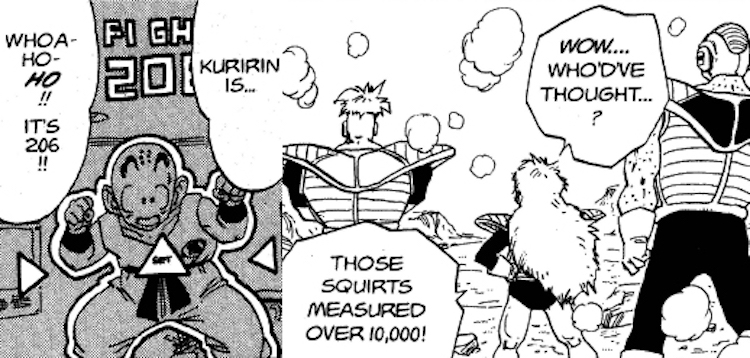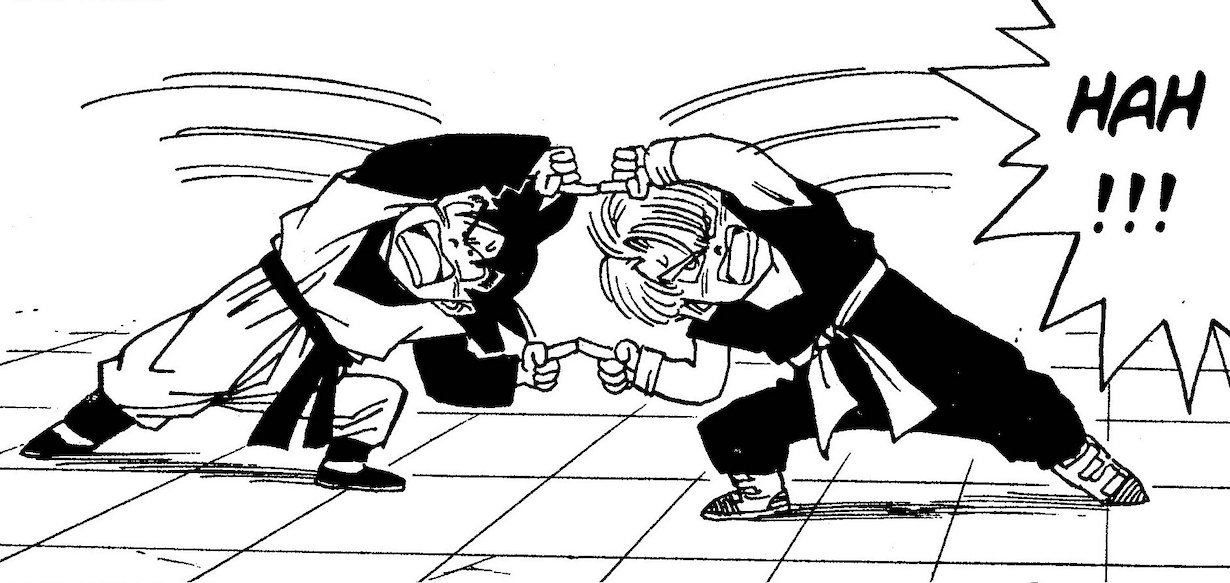NEWS
27.01.2022
The "Namekians Are Plants" Theory - Dragon Ball Fan Turned Biologist Explains the Mystical Link Between DB Characters and Evolution!

From Frieza and his many transformations to the Namekians, who require only water for survival, the world of Dragon Ball is home to a plethora of peculiar creatures—excuse me, peculiar characters.
I'm sure that while reading the comics, many of you have indulged the latent curiosity of your youth and wondered, "How do they do that...?"
They can change form, regenerate and heal themselves from the brink of death, and possibly the most mystifying of all, fuse their entire being with another to create a whole new character! You'd be forgiven for thinking that such abilities are a far cry from the bounds of reality.
But just for fun, allow me to play devil's advocate for a moment.
What if lifeforms like Frieza and the Namekians did exist? And in that case, what kind of evolutionary path would their species have traveled to end up the way they did? If that sounds like an entertaining thought experiment to you, then you're in luck because for this article, I had Dragon Ball fan and professional biologist Yudai Okuyama share with us his expert opinion on that very question!
The following is an interview conducted between Mr. Okuyama, Masayuki Kato, who is a writer and well-versed in biology, and an editor of the Dragon Ball Official Site.
Using "evolution" as a launchpad for our conversation, we go on to discuss a wide range of topics surrounding the mystical force that is life itself. Enjoy!

Writer: Masayuki Kato
Science teacher and writer, specializing in biology. Aged 6–16 during Dragon Ball's 10-year run in Jump, making him a representative specimen of the Dragon Ball generation.
Favorite Dragon Ball girl: Mai of the Pilaf Gang.

Interviewee: Yudai Okuyama
Researcher at the National Museum of Nature and Science, specializing in evolutionary biology. Purchased Weekly Shonen Jump every week as an elementary school student to read the latest Dragon Ball chapter.
Favorite hero of all time: Goku.
Are Frieza's Transformations a Form of Evolution?

Nice to meet you, Mr. Okuyama.
—Editor
Thank you very much for your time!

Sorry to jump right in, but would you be able to tell everyone what you do and what your specialty is?

Sure thing. Hello, everyone. I'm Yudai Okuyama, and my field of study is the evolution of plant life, particularly regarding how flowering plants evolved to attain their shapes, colors, aromas, and so on, and how they've changed with evolution.

Interesting! Speaking of changing shapes and colors, there are a lot of characters in the world of Dragon Ball like Frieza, Cell, and the Super Saiyans who can do just that! I'm here on orders from the editing department to talk about Dragon Ball characters in the context of evolution, but is evolution really the right word to describe Frieza's different forms or the Super Saiyan transformations? I'm a little dubious myself, but what do you think?

I'd have to agree. I don't think those would classify as evolution.
—Editor
Huh...?! Hold on a second. They're all radically changing how they look, right? If that's not evolution, then what is it...?

Metamorphosis.
—Editor
Huh...?

Evolution is when a group—not an individual—undergoes transgenerational changes to their nature or properties.
Take plants, for example. The shape of their flowers has evolved over many years through their relationship with other organisms that play a role in pollination.
Let's say there's a species of plant that attracts bees, but a portion of that plant's population undergoes a sudden change to the shape of its flowers such that they now attract hummingbirds instead. Because the bees don't visit the plants that the hummingbirds do and vice versa, the two groups of plants can no longer cross-pollinate, and as a result their evolutionary path will split into two branches. Somewhere down the line those plants might go on to develop new ways to spread pollen, the way they seed might change, or they might produce new scents with different properties, and all of that will also affect the shape of their flowers even further. This is what the process of evolution looks like, and it's the reason why we now have so many different kinds of plants on Earth.

A Bombus beaticola beaticola bumblebee
—Editor
I see...

In Frieza's case, his transformations aren't the result of transgenerational change, but instead appear to be some kind of metamorphosis related to his individual development.
—Editor
Okay, so the point we're splitting evolution and metamorphosis on is whether or not the changes occur over the course of several generations. Well, Kato, looks like our whole idea for this article's been snuffed out right from the get-go! What do you say? Do we pack it up now and head home early?

Not so fast. That may be so, but we've only just begun to scratch the surface of our passion for Dragon Ball and biology!
A Wild Hypothesis for Frieza's Ancestors

Evolution or not, Frieza's ability to transform is quite an amazing trait, is it not?

From a biological perspective, you could probably suggest that it's some kind of special hereditary property that originated with his ancestors.

Care to elaborate?

Frieza has horns in his first few transformations, right? But by the time he reaches his final form, they're gone, and instead he's got that kind of smooth, glossy head. I think there's more to that than we've been told.

For example, there are plenty of animals whose infant form is quite different from their mature form, such as shrimp and crabs that start out as zoea. By and large, animals who fall into that category have a spiky appearance in their infancy as a form of natural self-defense.

Zoea! Those are the little guys you find mixed in with dried shirasu sometimes!


There are even species of water fleas that have extendable spikes to use when they're under attack. Spikes are a very important defense mechanism for weak or vulnerable organisms.
So if you think about it that way, it's likely that Frieza's ancestors were actually some kind of very weak lifeform that relied on their spikes to protect themselves until they could metamorphize enough times to reach maturity.

Clawing their way up from being the little odd bits in dried shirasu all the way to being the emperors of the universe... Talk about a reversal of fortunes!
A Biological Perspective on Saiyan-Earthling Hybrids

Let's try thinking about evolution in Dragon Ball from an angle other than metamorphosis. One thing I'm very curious about is the idea of Saiyan-human hybrid characters like Gohan. What would you say to the notion that Gohan is an example of heterosis at work?

—Editor
...What exactly is heterosis?

Heterosis or hybrid vigor is a term used to describe when a hybrid offspring benefits from the biological advantages of both their parents and ends up stronger than them—basically, getting the best of both worlds. In agriculture, farmers utilize the mechanisms of heterosis to do things like make their crops grow to uniform sizes, to be more resilient, to taste better, that sort of thing. (selective breeding)
As for Gohan, you could propose that his strength is the result of heterosis. However, manifesting this phenomenon isn't all that simple—it's often the case that both parents need to possess particularly strong advantageous traits.

Ah... When you put it that way, I can't really think of any prominent examples of an advantageous trait that humans have when compared to Saiyans.

There are some scenes that come to mind, however. How about "potential" as the advantageous trait of an Earthling? Krillin, for example, was able to increase his Power Level by around fifty times between the Saiyan Arc and the Frieza Arc.


You're right! A lot of other Earthlings have shown an almost abnormal potential for growth as well. Gohan already had a Power Level of 1,000 when he was just a kid, so considering Krillin's rate of improvement, that would make Gohan's potential absolutely incredible!

Also, when the Ginyu Force were talking about Gohan and Krillin, they mention something about it being rare for a species to be able to change their Power Levels without transforming, so maybe that could be another advantageous trait of humans. In Gohan's case, it seems that this trait—a trait that Saiyans don't naturally possess—is one that complements his Saiyan heritage unexpectedly well.

I'd have to really tip my hat to Akira Toriyama if he'd planned in advance to make Gohan turn out that way by having Goku marry Chichi...

Planet Namek's Saichoro Is "Queen Bee"?!

Now, I don't know if we can tie this back into evolution, but I've always been curious about the Namekians from a biological standpoint when reading Dragon Ball. They hatch from eggs, need only water to survive... Just what kind of evolutionary path would they have traversed to end up this way?

This is something that always interested me when I was reading Dragon Ball too.
All the current Namekians from Planet Namek that we know of hatched from eggs from Saichoro, right? Isn't that incredible? There are so many other mature Namekians, and yet they don't propagate. Biologically speaking, Namekians might be an example of a species where only one member of a group is able to reproduce at all.


Like...like the queen bee in a colony of honeybees.
When you think about it, it looks like he's too large to even fit through the front door of his house, which is just like a queen bee in real life!


However, before Saichoro passed away, he himself designated Muri to succeed him. In the case of a bee colony, if the queen dies, the colony will perish, and so I think we can say that bees and Namekians are not quite the same.

Ah! I think I've got it! Maybe they're closer to something like a naked mole-rat then. The matriarch of a naked mole-rat colony is the only one that can reproduce, and when they die, one of the remaining members of the colony will become the new queen and begin to reproduce instead.

I see. In that case, perhaps Saichoro emits some kind of pheromone that inhibits the reproductive capabilities of the other members of the species. (Note: In the case of naked mole-rats, the matriarch emits pheromones that inhibits ovulation in other females.)

I can't even begin to imagine what Saichoro's pheromones would smell like...
Do Namekians Get Their Energy through Photosynthesis?


Namekians are able to subsist solely on water, right? Where do you suppose they're acquiring the energy needed for survival?

In terms of biology, I'd propose that they get their energy via photosynthesis, just like plants. They are green, after all.

You might be right. Planet Namek has three suns and no nighttime, so photosynthesis would actually be the ideal method of generating energy for the environment they live in.

In fact, there are animals that live symbiotically with algae or whose bodies contain chloroplasts who use photosynthesis to generate energy. Coral is a famous example of this, but there are others too. One of them a species of sea slug called Plakobranchus ocellatus that actually kind of looks like a Namekian.

A Plakobranchus ocellatus sea slug (Chaloklum Diving / Wikimedia Commons)

Woah, they really do kinda look like Namekians! I can imagine if they had an encyclopedia of evolution on Planet Namek, there'd be an entry with a picture of one of these guys, saying, "This is you—500 million years ago!"

There's still a ton of interesting things about Planet Namek. For example, there's a rather unique species of tree on Namek called "Ajisa" that has just one little round bulb of leaves right at the top of its thin trunk.

In the real world, trees found in tropical rainforests tend to resemble this shape. The reason they grow that way is because in dense tropical rainforests, areas other than the top canopy are unsuitable for the purpose of photosynthesis. Take a look at this picture of a Koompassia tree that grows in rainforests in Malaysia. Don't you think it looks like one of Planet Namek's Ajisa?

A Koompassia tree (Bobbean / Wikipedia)

No kidding. Would you say that their shape is the result of evolution?

Well, Planet Namek was supposedly a verdant paradise before the radical climate shift that occurred there, so perhaps Ajisa had evolved to thrive in the forests that used to be so abundant. As an evolutionary biologist, I’d love to be able to see Planet Namek hundreds of years ago before the climate shift. The way Piccolo describes it really ignites my imagination.
Cell's Absorption Ability Exists in the Real World?!

Speaking of Planet Namek's past, we talked before about how the primitive form of Namekians could be something like a photosynthesizing sea slug. How do they work? Is it just an algae cell living inside a sea slug?

No, it's actually quite interesting. The chloroplasts in the sea slugs have a more aggressive origin—they're called "kleptoplasts," and they're a rare kind of organism that steals chloroplasts from other organisms. They're kind of like Cell, don't you think?
There are other lifeforms that absorb the abilities of other organisms and make them their own too.
For example, there's a species of luminescent fish called Parapriacanthus ransonneti, but they actually get the ability to emit light from a protein in their diet of sea fireflies, or Vargula hilgendorfii. They don't digest it, so it just gets absorbed into their bodies.

A school of Parapriacanthus ransonneti

That's...that's just like Cell!


Perhaps his creator, Dr. Gero, took inspiration from this kind of natural phenomenon when designing Cell with his ability to absorb people and steal their power.
Was Fusion Just "Grafting" All Along?!

It's getting a little stuffy in here, so what do you say we take a walk around my outdoor research area?
*Mr. Okuyama gets to work on his research while surrounded by plant life at Tsukuba Botanical Garden (Tsukuba City, Ibaraki Prefecture)!

R-Really?! I'm actually a huge fan of this place—I even bought the year-pass and came to see all the special exhibits!

I'm honored! It might sound a little sinister, performing research and experiments day in day out in a botanical garden, but I promise we're not developing Saibaimen or anything.
Let me show you around a research area that isn't generally open to the public.

In the depths of the botanical research area, a mysterious greenhouse came into view...
Take a look at this pot plant. Does it remind you of anything?


Let's see... It just looks like a regular old pot plant to me?

What you're looking at is actually a species related to apple trees called Takanabe kaido grafted onto a Siebold's crabapple, or Malus toringo. This is a different concept again to evolution, but the process of grafting, whereby two different trees can join and become one, is rather like fusion in Dragon Ball, don't you think?



Grafting?!?! ...Sorry, I tried to give a good reaction there, but grafting is a technique that's been used by humans for thousands of years, isn't it? Technically you could call it a form of "fusion", but isn't using something as common as grafting to explain away something as mystifying as fusion a little...boring?

By no means! Grafting is incredible—it was even used in 19th century Europe to solve the problem of pests decimating grape crops. They grafted their grape plants with American grape plants to make a whole new species that could survive the epidemic.

So you're saying that the concept of combining two things into something stronger with grafting makes it somewhat similar to fusion?

Certainly. And not only that—we've had some interesting advancements in the field in recent years. Research has shown that if you use a tobacco plant as a sort of cushion between the two plants you're trying to graft, you can successfully graft plants that belong to different species altogether, which was something thought to be impossible until this discovery. It's really groundbreaking stuff. Using this new technique, in theory it's possible to fuse just about any kinds of plants together.

Seriously?! That's incredible! That would be like...like fusing Piccolo, Frieza, Majin Buu, and Mr. Satan all into one fighter!!

—Editor
Did you really need to bring Mr. Satan into that...?
Well, that brings us to the end of our candid talk with Mr. Okuyama about the connection between Dragon Ball characters and evolution.
Dragon Ball begins to add a lot of sci-fi elements from the Saiyan Arc and onward, but it also retains a lot of the fantasy of its earlier days, so analyzing all the weird and wonderful things that appear throughout from a scientific perspective can really add a whole new layer of enjoyment.
We might not be too far from the day when all the kids who read Dragon Ball have grown up to become great professors and scientists like Dr. Brief!

Mr. Okuyama's personal comic collection that he brought along on the day of the interview
This site includes machine-translated texts. Please be aware that you might find some unusual expressions that are difficult to understand.
Post
Confirm Post
Post the above comment?
Reply
Confirm Reply
Post the above comment?
Are you sure you want to delete this comment?
Report successful
Post Unsuccessful
This user will be muted.
You will be unable to see comments from muted users in the comments area.
*To unmute users, navigate to the "Comments" area on MY PAGE.
Reply
Confirm Reply
Post the above comment?
Edit
Post


Post
Confirm Post
Post the above comment?
Edit
Post